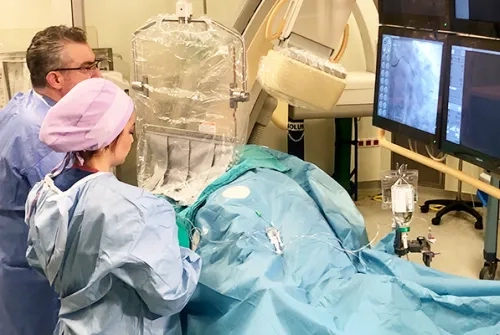Alo Yeditepe
Alo Yeditepe
What is a Heart Attack? What are the Symptoms of a Heart Attack?
The incidence of heart attacks is increasing day by day in the world and in Turkey. Cardiology Specialist Prof. Dr. Olcay ÖZVEREN said that heart attacks can occur in all age groups and made statements about risk factors. Dr. ÖZVEREN stated that any pain between the jaw and the navel could be a sign of a heart attack. Prof.Dr. Olcay ÖZVEREN also drew attention and warned about cold weather and early morning hours. Dr. ÖZVEREN underlined that the risk of heart attack can be determined in advance with some imaging methods, especially in people with risk factors, and thus it is possible to prevent possible crises.
It is known that approximately 33 percent of all deaths in the world and in Turkey are caused by cardiovascular diseases. Obesity, sedentary lifestyle, smoking, family history of heart disease, and presence of diabetes are among the risk factors for heart attack. To prevent heart attack, it is necessary to eliminate modifiable risk factors.
What is a Heart Attack?
Heart attack, medically defined as "myocardial infarction a.k.a. MI ‘’is a condition in which the blood flow in a certain area of the heart is suddenly interrupted due to occlusion of one or more of the coronary arteries due to different reasons, causing damage to the tissues in that area. Coronary arteries, which form the main vessels that carry blood to the heart, often become blocked as a result of a process called atherosclerosis. Atherosclerosis occurs when artery walls accumulate and harden with cholesterol and other substances. These deposits can form plaques over time and narrow or block the inner walls of the arteries. Ultimately, this blockage can result in a heart attack. Heart attacks are serious conditions that require urgent medical intervention. Early diagnosis and treatment can reduce the risk of complications after a heart attack and help heart functions return to normal as quickly as possible.

What are the Risk Factors for Heart Attack?
Heart attack (myocardial infarction) is a serious condition that can occur as a result of the interaction of many different factors. Risk factors that may cause this result are listed as follows:
Smoking
Smoking is a major risk factor for heart attack. Smoking can cause arteries to harden and clog. Quitting smoking alone reduces the risk of heart attack by up to 36 percent.
High Cholesterol
High cholesterol levels also increase the risk of heart attack and cardiovascular diseases. Treating this and lowering cholesterol levels alone are among the factors that reduce the risk of heart attack.
High Blood Pressure (Hypertension)
High blood pressure can damage your heart and blood vessels. This increases your risk of heart attack.
Diabetes
If there is diabetes for heart attack, diabetes regulation is very important. High blood sugar causes atheroma plaque to form on the vessel wall. This is one of the most obvious situations on the way to a heart attack. Regulating this situation is among the factors that reduce the risk of heart attack.
Stress
Stress alone constitutes a minor risk factor on the road to heart attack. Intense stress can cause problems related to hormonal balance, increase heart rate, and change the vasomotor response in the coronary vessels. Therefore, stress constitutes one of the most important risk factors on the road to heart attack.
Obesity and Lack of Physical Activity
Obesity can increase blood pressure, affect cholesterol levels and increase the risk of diabetes. Not being physically active can also increase the risk of heart attack. Exercise is important for heart health. Daily exercise of 10-13 thousand steps or 5 kilometers per hour also reduces the risk of heart attack.
What are the symptoms of a heart attack?
Heart attack symptoms consist of a wide spectrum. While on the one hand, there is a situation defined as sudden death, on the other hand, the patient may have a silent heart attack. It is more common especially in diabetic patients and older age groups. In such patient groups, the cardiovascular system may be blocked, but the person may not notice it. When you consult a doctor for different reasons, some imaging methods or physical examination can detect the condition.
The most common heart attack symptom in patients is chest pain. Pain anywhere between the jaw and the navel can be a sign of a heart attack. This pain is mostly in the form of pain that spreads and is reflected in the anterior chest wall, back, arms, shoulders, jaw, stomach and esophagus area and lasts for at least 5 minutes. It usually increases with exertion and disappears with rest. If there is such a clinical finding, it would be beneficial to consult the nearest physician.

What to Do During a Heart Attack?
"The most basic thing to do when you encounter a heart attack is to stay calm," said Prof. Dr. Olcay Özveren: “Because in cases of stress, excitement and fear, the heart accelerates and the workload increases. In this sense, it is necessary to calm the person and manage the crisis by calling 112 and calling an ambulance. On the other hand, if you have an aspirin at hand, it can be administered to the patient at 300 milligrams. "There is no equivalent to maneuvers such as laying the patient down and lifting his feet or making him cough," he said.
Is It Possible to Predict the Risk of Heart Attack?
With the development of technology and imaging methods becoming more accessible and cheaper, the risk of heart attack has reached a point where it can be determined in advance. Especially with the widespread use of tomographic angiography, the presence of vascular disease can be detected with almost 100 percent accuracy. This is beneficial in determining and preventing the risk of heart attack. Of course, imaging methods also have complications and side effects. Since there are imaging methods using radiation, they are not applicable to everyone. Patients are determined according to their risk factors. For example, those with diabetic atypical chest pain, heavy smokers, those with a family history of the disease, and people under the age of 65. Age is an important factor, as calcification is especially common in coronary arteries over the age of 65. Because calcification in the cardiovascular system makes diagnosis difficult. In people with this situation, methods such as nuclear medicine methods or medicated echocardiographic methods or cardiac MRI are used. Recently, there have been developments in health guidelines around the world that it should be administered to people with risk factors.
Frequently Asked Questions About Heart Attack
Does Having a Heart Attack Once Increase the Risk?
Prof. Dr. ÖZVEREN stated that a person who has a heart attack for the first time is in a very high risk group within the next 10 years. Dr. ÖZVEREN said, “After having a heart attack, the risk of encountering a second or third heart attack increases in this sense. If you have had a heart attack once or if your heart artery is found to be blocked, you are in a very high risk group. The rate of having a heart attack again in the next 10 years can increase by almost 30 percent. In other words, 3 out of 10 patients who have had a heart attack are likely to have another heart attack within 10 years. To prevent this, we minimize existing risk factors by treating them; it may not be possible to eliminate them completely. "If you modify and treat the risk factors, the rate of heart attack decreases significantly," he said.
What is the connection between cold weather and heart attacks?
Prof. Dr. Olcay ÖZVEREN also warns against cold weather and early morning hours. Dr. ÖZVEREN: In studies and clinical practice, we see that as the weather gets colder in the winter months, the rate of constriction of the vessels, which we call vasospasm, increases. This causes chest pain symptoms and therefore increases the risk of heart attack. We all have a circadian rhythm in our body. "Due to the change in neurohormonal balance in this circadian rhythm in the morning, the risk of heart attack increases even more," he said.
Does Having a Heart Attack Cause Other Heart Diseases?
Prof. Dr. Olcay ÖZVEREN said that heart attack can also lead to other heart-related diseases. Dr. ÖZVEREN said, “For example, heart attack and cardiovascular occlusion related to the front side of the heart can also cause heart failure if not treated in the future. "Heart attack is also one of the causes of some heart valve diseases," he said.
Does Taking 10 Thousand Steps a Day Reduce the Risk?
New studies have confirmed that this is not a myth. To put it simply, exercises performed at a speed of 5.2 kilometers per hour reduce the risk factors for cardiovascular diseases and heart attack.
Does Intense Exercise to Increase Muscle Mass Increase the Risk of Heart Attack?
Stating that intense exercise increases the risk of heart attack, Prof. Dr. Olcay ÖZVEREN said, “What we call a heart attack is actually a condition that occurs when the heart vessel is blocked. Situations that result in sudden deaths, especially in young athletes, are caused by disease groups other than cardiovascular diseases. It originates from the disease we call hypertrophic cardiomyopathy, which is accompanied by some rhythm problems or thickening of the heart muscle. Balanced nutrition and regular exercise are important in this sense. We especially recommend isotonic exercises in this sense. In other words, exercises should be done to increase muscle length, not to thicken the heart muscle. These; Exercises such as swimming, running, fast walking, cycling. We know that this type of exercise prevents the risk of heart attack. But exercises aimed at increasing muscle mass by lifting weights increase blood pressure and increase the risk of heart attack. "We observe these in the studies carried out," he said.
About
Faculty and Year of Graduation:
İ.U. Cerrahpaşa Faculty of Medicine, 2000
”
See Also
- What is Heart Rhythm Disorder (Arrhythmia)? Symptoms and Causes
- What is Sudden Cardiac Death? What are the Symptoms?
- Carotid Artery Disease
- What is Intravenous Ultrasound (IVUS)?
- The Risk of High Blood Pressure Increases as You Go to High Altitudes
- By 2025, Hypertension Patients Are Expected to Reach 1.5 Billion
- Misconceptions about the Female Heart
- Coronary CT Angiography (Virtual Angiography)
- Effort Test
- Heart Attack Causes and Symptoms
Alo Yeditepe




